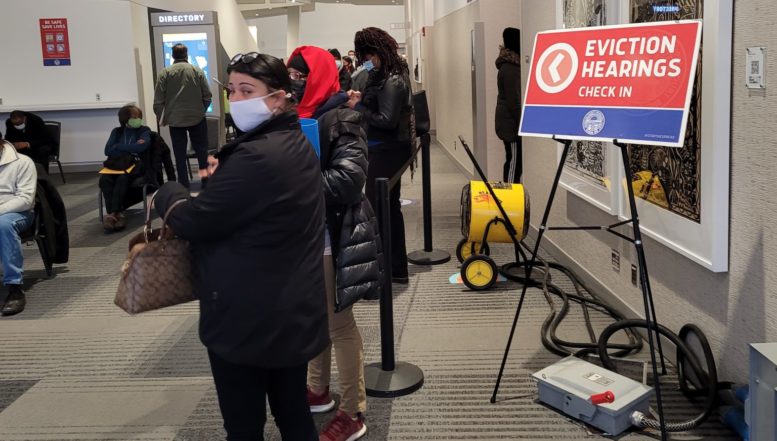When the new coronavirus emerged, a rush of 43 states and Washington D.C. instituted an eviction moratorium, temporarily blocking landlords from ousting tenants from their housing during a health crisis.
Not Ohio.
Two recent studies highlight Ohio’s lack of action on evictions as most other states, the U.S. Congress and eventually the CDC moved on the issue.
In one study, published in the American Journal of Epidemiology, researchers from March to September of 2020 measured COVID-19 infection rates in the 17 states that maintained an eviction moratorium throughout against the 27 states that lifted it during the study period.
“Lifting eviction moratoriums was associated with increased COVID-19 incidence and mortality in U.S. states, supporting the public health rationale for use of eviction moratoriums to prevent the spread of COVID-19,” the study states. “Effects grew over time, perhaps due to mounting displacement, crowding, and/or homelessness as evictions proceeded.”
In another, the Eviction Lab, a research group at Princeton University, along with Wake Forest University Law School professor Emily Benfer, went state-by-state analyzing how the U.S.(legislatures, governors, or courts) regulated eviction between March 2020 and June 2021, including:
- Initiation of eviction: Whether a state blocked landlords from filing an eviction for nonpayment of rent related to COVID-19
- Court process: Whether a state suspended eviction court proceedings
- Enforcement: Whether a state blocked law enforcement from executing an eviction order, including for COVID-19 related hardship
- Short-term supports: Whether a state extended eviction moratoriums past the state of emergency, provided grace periods to pay late rent, or stopped landlords from reporting to credit bureaus.
- Tenancy preservation measures: Whether a state barred late fees, provided tenants legal representation in eviction court, provided rental assistance or other rent relief measures (only counts if applied during an eviction moratorium), and barred rent raises during and after the pandemic
Ohio was one of seven states to win zero of five stars on the scale, alongside Wyoming, South Dakota, Oklahoma, Missouri, Georgia, Arkansas, and Arizona. It didn’t satisfy any positive criteria among the metrics.
It wasn’t a simple red-state blue-state dichotomy either. Neighboring states with significant Republican control like Kentucky, West Virginia and Pennsylvania all outperformed Ohio, according to the Eviction Lab study.
In Franklin County, Ohio’s most populous, officials relocated eviction court hearings last summer from the county courthouse to the Columbus Convention Center to “provide adequate space” to adhere to social distancing guidelines.
“Trade shows aren’t allowed yet but homelessness is,” Benfer wroteon social media at the time. “Turning families on the street during a pandemic is not justice.”
Where evictions stand
The U.S. Congress issued a 120-day eviction moratorium that expired in July 2020. One month later, the CDC issued a temporary ban that expired July 31, 2021 (after several extensions). The ban, however, required tenants to opt-in to the system after an eviction had been filed, leaving tenants — many of whom appear before eviction courts without a lawyer — unaware.
Shortly before the moratorium expired, a U.S. Supreme Court opinion cast doubt on the CDC’s legal authority to impose such a moratorium. Additionally, a panel of judges with the U.S. Court of Appeals for the Sixth Circuit unanimously agreed the CDC does not have the power to implement an eviction moratorium without congressional approval.
On Aug. 2, Supreme Court Chief Justice Maureen O’Connor issued guidance to lower court judges reminding them of available rent relief, mediation strategies in landlord-tenant disputes, and other recommendations.
On Aug. 3, the CDC issued a new, narrower ban, blocking evictionsin counties with “substantial” or “high” levels of COVID-19 spread. The agency said it’s a means to combat the hyper-transmissible Delta variant of the coronavirus, which has been tearing through unvaccinated communities throughout the U.S.
All but a handful of Ohio’s counties currently host substantial or high levels of COVID-19 spread, according to the CDC.
Since then, the Franklin County Municipal Court announced it would defy the CDC’s latest moratorium and continue eviction proceedings, citing the appellate court decision.
Ed Miller, a spokesman for the Ohio Supreme Court, declined to comment when asked what guidance has been offered to lower courts given the ongoing legal dispute.
“It’s a bit of a mess,” said Marcus Roth, a spokesman for COHHIO, which advocates for affordable housing.
In an interview, Roth said while an eviction moratorium may have been helpful, federal money sent to states to provide tenants with rent relief is the real gamechanger — it just needs to speed up.
Congress provided the state with $565 million for emergency rental assistance program, with another $210 million going directly to large Ohio cities. The state allocated another $111 million from CARES Act funding (federal coronavirus relief) to create a Home Relief Grant Program, which offers assistance with rent, mortgages and utility bills.
Of that $565 million, only about $79 million — roughly 14% — has gone out to 12,680 households, according to a spokesman with the Department of Development. Since November 2020, the department has used $135 million from various funding sources including the emergency rental assistance program to assist 38,000 households.
It’s not just an Ohio issue. An NBC News investigation from late July found that among 41 states, 26 had distributed less than 10 percent of their first allocations.
Roth said some of this is to be expected: Governments don’t create new programs quickly, money takes a long time to flow between government agencies, and onerous reporting and application requirements can all bog things down. But patience, he said, could pay off.
“If emergency rent assistance is well-administered in Ohio, it can make a significant difference in the long-term eviction crisis and housing instability problem we’ve been dealing with for years here,” he said.
***
Also from Ohio Capital Journal:
Study finds Vax-a-Million lottery responsible for vaccinating over 100,000 additional Ohioans
A new study in The American Journal of Medicine found that Ohio’s Vax-a-Million lottery incentive program caused more than 100,000 additional Ohioans to get vaccinated at a cost of about $49 per new Ohioan vaccinated.
The Harvard study contradicts a Boston University School of Medicine study that made news last month suggesting that the Vax-a-Million lottery was not associated with increased adult COVID-19 vaccination rates in Ohio.
The Harvard study was conducted by comparing Ohio’s vaccination rate during and after the lottery to the vaccination rate of a control region.
Using a statistical technique, study author Neil Sehgal used demographic and COVID-19 vaccination data from a combination of similar parts of other states to create “synthetic Ohio,” a region that closely resembles Ohio in order to model vaccination rates in the state prior to the lottery announcement. READ MORE
State leadership gives mixed reviews for federal change to Medicaid work requirement
Ohio Gov. Mike DeWine said he’s disappointed in the Biden administration’s reversal in approving a work requirement waiver for Medicaid recipients.
The Centers for Medicare & Medicaid Services ended a Trump-era policy that permitted the state to require work or “community engagement activities” as a condition of Medicaid eligibility, according to a letter sent to the Ohio Department of Medicaid’s director, Maureen Corcoran.
DeWine called the decision short-sighted and “contrary to our statewide effort to improve public health” in a statement on Wednesday.
“By requiring an individual to work, learn new job skills or be involved in a recovery program, Ohioans would be providing critical assistance to individuals when they needed it while laying hte groundwork for their success in the future,” DeWine’s statement read.
Ohio Democratic U.S. Senator Sherrod Brown praised the decision, said in a statement that “burdensome work requirements create a barrier to health care for those who need it most, especially those who suffer with addition.” READ MORE





